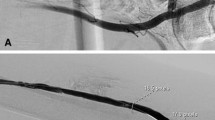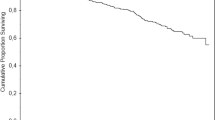Abstract
Background
Dialysis-associated steal syndrome (DASS) is a multifactorial complication. There are several therapeutic options, although because of the lack of research decisions for certain procedures are often made individually. The aim of this retrospective survey was to propose a new classification for DASS, including therapeutic recommendations, to make standardized procedures easier.
Methods
A total of 63 patients (2001–2006) treated for DASS following autogenuous hemodialysis access (HA) were included in this survey. In 55 (87%) of these patients, surgery was performed. The courses of disease of the patients were evaluated according to clinical symptoms, HA-specific features, and therapeutic results. Statistical evaluation was performed by SSPS software.
Results
Eight patients with mild symptoms were treated successfully using conservative therapy. In 17 patients with pain during exercise or acute neurologic deficiencies, HA banding led to good results. In the case of acral lesions, however, banding was unsuccessful, although interruption of the retrograde flow was sufficient therapy in 94% of cases. Preservation of the HA was unsuccessful in all patients with extended tissue loss (n = 10). Statistical evaluation showed that tissue loss was generally associated with diabetes (p < 0.001) and peripheral arterial occlusive disease (p = 0.001).
Conclusion
In addition to steal phenomenon (stage I), which can be treated conservatively, there are three stages of DASS following autogenuous HA that require surgical intervention (stage II, no acral lesions; stage III, small acral lesions; stage IV, extended acral lesions). HA banding leads to good results in stage II; in patients with stage III, interruption of the retrograde flow is indicated. However, in patients with extensive tissue loss (stage IV), closure of the HA should be considered.


Similar content being viewed by others
References
Yeager RA, Moneta GL, Edwards JM et al (2002) Relationship of hemodialysis access to finger gangrene in patients with end-stage renal disease. J Vasc Surg 36:245–249
Tordoir JH, Dammers R, van der Sande FM (2004) Upper extremity ischemia and hemodialysis vascular access. Eur J Vasc Endovasc Surg 27:1–5
White JG, Kim A, Josephs LG et al (1999) The hemodynamics of steal syndrome and its treatment. Ann Vasc Surg 13:308–312
Unek IT, Birklik M, Cavdar C et al (2005) Reflex sympathetic dystrophy syndrome due to arteriovenous fistula. Hemodial Int 9:344–348
Henriksson AE, Bergqvist D (2004) Steal syndrome after brachiocephalic fistula for vascular access: correction with a new simple surgical technique. J Vasc Access 5:13–15
Davidson D, Louridas G, Guzman R et al (2003) Steal syndrome complicating upper extremity hemoaccess procedures: incidence and risk factors. Can J Surg 46:408–412
Lazarides MK, Staramos DN, Kopadis G et al (2003) Onset of arterial “steal” following proximal angioaccess: immediate and delayed types. Nephrol Dial Transplant 18:2387–2390
Miles AM (1999) Vascular steal syndrome and ischaemic monomelic neuropathy: two variants of upper limb ischaemia after haemodialysis vascular access surgery. Nephrol Dial Transplant 14:297–300
Roca-Tey R, Rivas A, Samon R et al (2005) Study of vascular access (VA) by Doppler ultrasonography (CDU): comparison between delta-H and CDU methods in measuring VA blood flow rate. Nefrologia 25:678–683
Weinberg DH, Simovic D, Isner J et al (2001) Chronic ischemic monomelic neuropathy from critical limb ischemia. Neurology 57:1008–1012
Thermann F, Ukkat J, Wollert U et al (2007) Dialysis shunt-associated steal syndrome (DASS) following brachial accesses: the value of fistula banding under blood flow control. Langenbecks Arch Surg 392:731–737
Zanow J, Petzold K, Petzold M et al (2006) Flow reduction in high-flow arteriovenous access using intraoperative flow monitoring. J Vasc Surg 44:1273–1278
Korzets A, Kantarovsky A, Lehmann J et al (2003) The “DRIL” procedure: a neglected way to treat the steal syndrome of the hemodialysed patient. Isr Med Assoc J 5:782–785
Jean-Baptiste RS, Gahtan V (2004) Distal revascularization-interval ligation (DRIL) procedure for ischemic steal syndrome after arteriovenous fistula placement. Surg Technol Int 12:201–205
Zanow J, Kruger U, Scholz H (2006) Proximalization of the arterial inflow: a new technique to treat access-related ischemia. J Vasc Surg 43:1216–1221
Davidson D, Louridas G, Guzman R et al (2003) Steal syndrome complicating upper extremity hemoaccess procedures: incidence and risk factors. Can J Surg 46:408–412
Valji K, Hye RJ, Roberts AC et al (1995) Hand ischemia in patients with hemodialysis access grafts: angiographic diagnosis and treatment. Radiology 196:697–701
DeCaprio JD, Valentine RJ, Kakish HB et al (1997) Steal syndrome complicating hemodialysis access. Cardiovasc Surg 6:657–659
Papasavas PK, Reifsnyder T, Birdas TJ et al (2003) Prediction of arteriovenous access steal syndrome utilizing digital pressure measurements. Vasc Endovasc Surg 37:179–184
Lazarides MK, Staramos DN, Panagopoulos GN et al (1998) Indications for surgical treatment of angioaccess induced arterial “steal”. J Am Coll Surg 187:422–426
Goff CD, Sato DT, Bloch PH et al (2000) Steal syndrome complicating hemodialysis access procedures: can it be predicted? Ann Vasc Surg 14:138–144
Odland M, Kelly PH, Ney AL et al (1991) Management of dialysis-associated steal syndrome complicating upper extremity arteriovenous fistulas: use of intraoperative digital photoplethysmography. Surgery 110:664–669
Ehsan O, Bhattacharya D, Darwish A et al (2005) Extension technique: a modified technique for brachio-cephalic fistula to prevent dialysis access associated steal syndrome. Eur J Vasc Endovasc Surg 29:324–327
Allon M, Lockhart ME, Lilly RZ et al (2001) Effect of preoperative sonographic mapping on vascular access outcomes in hemodialysis patients. Kidney Int 60:2013–2012
Aschwanden M, Hess P, Labs KH et al (2003) Dialysis access-associated steal syndrome: the intraoperative use of duplex ultrasound scan. J Vasc Surg 37:211–213
Martinelli P, Baruzzi A, Montagna P et al (1981) Carpal tunnel syndrome in a patient with a Cimino-Brescia fistula. Eur Neurol 20:478–480
Harding AE, Le Fanu J (1977) Carpal tunnel syndrome related to antibrachial Cimino-Brescia fistula. J Neurol Neurosurg Psychiatry 40:511–513
Hye RJ, Wolf YG (1994) Ischemic monomelic neuropathy: an under-recognized complication of hemodialysis access. Ann Vasc Surg 8:578–582
Minion DJ, Moore E, Endean E (2005) Revision using distal inflow: a novel approach to dialysis-associated steal syndrome. Ann Vasc Surg 19:625–628
Goel N, Miller GA, Jotwani MC et al (2006) Minimally invasive limited ligation endoluminal-assisted revision (MILLER) for treatment of dialysis access-asssociated steal syndrome. Kidney Int 70:765–770
Thermann F, Kornhuber M, Brauckhoff M (2006) Dialysis shunt-associated ischaemic monomelic neuropathy: neurological recovery preserving the dialysis access. Nephrol Dial Transplant 21:3334–3336
Zanow J, Petzold K, Petzold M et al (2006) Flow reduction in high-flow arteriovenous access using intraoperative flow monitoring. J Vasc Surg 44:1273–1278
Author information
Authors and Affiliations
Corresponding author
Rights and permissions
About this article
Cite this article
Thermann, F., Wollert, U., Dralle, H. et al. Dialysis Shunt-Associated Steal Syndrome with Autogenous Hemodialyis Accesses: Proposal for a New Classification Based on Clinical Results. World J Surg 32, 2309–2315 (2008). https://doi.org/10.1007/s00268-008-9677-7
Published:
Issue Date:
DOI: https://doi.org/10.1007/s00268-008-9677-7




